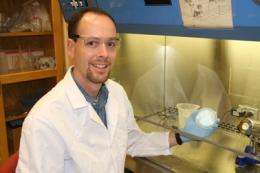Professors work to quickly, accurately identify deadly bacteria

(Phys.org) —It may sound like science fiction, but the bacterium known as MRSA is very real and very dangerous. MRSA is resistant to antibiotics, making it difficult to treat. Quickly identifying MRSA as the culprit in a person's infection is key to avoiding serious health consequences and possibly death.
Arizona State University's Todd Sandrin is among the authors of a new study, published in the academic journal Letters in Applied Microbiology, that moves scientific knowledge forward regarding development of rapid and accurate testing for MRSA. The testing method relies on a state-of-the-art mass spectrometer that is one of many pieces of research instrumentation available to faculty and students in ASU's New College of Interdisciplinary Arts and Sciences.
"Put simply, a mass spectrometer is a very sensitive and accurate scale that weighs very small things," explained Sandrin, associate director of New College's School of Mathematical and Natural Sciences and associate vice provost at ASU's West campus. "It does so by vaporizing small amounts of substances, in this case pieces of microorganisms, and launching them down a tube."
Based on the length of time it takes different molecules to travel through the mass spectrometer's tube, they can be identified based on their differing masses.
"A medical doctor approached me after one of my undergraduate researchers presented at a conference to tell me about his hospital experiences that make it clear how critical it is to identify MRSA quickly and accurately, and the mass spectrometer can do so in a matter of minutes," Sandrin said. "The issue is how accurate and reliable results are with the mass spectrometer. DNA testing also can identify MRSA, but that method is relatively slow, labor-intensive and expensive."
Multiple researchers have been using mass spectrometry to characterize MRSA and distinguish it from a similar "bug," MSSA, which is less dangerous because it can be treated with common antibiotics. But results have been mixed, with differences in experimental procedures including sample preparation and analysis affecting the quality and reproducibility of the findings.
The paper in Letters in Applied Microbiology represents the first rigorous examination of how differences in the way a sample is prepared and processed affect results. The bacteria to be tested may be grown either in agar or in broth, and it may undergo one of two preparation methods, known as the intact cell method and the protein extraction method.
Sandrin and his co-authors reported results showing a clear preference for growing cultures in broth and processing them using a protein extraction-based approach.
"We expect that these findings will enhance future efforts to use mass spectrometry to characterize strains of MRSA," Sandrin said.
That will be good news for everyone, as MRSA can be found on commonplace items, such as athletic equipment that might be shared by students at school. It even can be found on the surfaces of equipment in ambulances. In fact, that's exactly where the samples came from that were used in the study by Sandrin and his colleagues. The MRSA samples were collected by students of study co-author James Rago, a biology faculty member at Lewis University in Illinois.
One of Rago's undergraduate students, Peter Waller, visited the West campus and used the mass spectrometer in Sandrin's lab for a week in 2011, during the early stages of the research that led to the Letters in Applied Microbiology article.
"The benefits for our students are obvious and immeasurable," said Rago, regarding Waller's New College visit. "Lewis University and other schools benefit by forming meaningful collaborations and our students get to have a hand in crafting and advancing scientific knowledge."
Another co-author of the paper is School of Mathematical and Natural Sciences professor Connie Borror, a statistician who conducted statistical analysis of the data regarding the quality and reproducibility of results on different samples gathered from the mass spectrometer. "A real problem is that often these 'bugs' are so similar, it is hard to differentiate between them based on the data we obtain," Borror said. "Using appropriate statistical methods, we have a better chance at figuring out which bug we have – the bad one, or the one that's even worse."
"This type of collaboration is typical for School of Mathematical and Natural Sciences faculty," said Sandrin, who also engages in collaborative work with faculty members and students from other ASU entities, including the Biodesign Institute and the Ira A. Fulton Schools of Engineering.
Sandrin describes his research as residing at intersections of microbiology and chemistry. His work with mass spectrometry and "bugs" extends beyond MRSA to E. coli and other microorganisms of medical and environmental importance. His work in this area has received national and international attention. Sandrin just published a review article about this topic in Mass Spectrometry Reviews, one of the top journals in spectroscopy. He routinely delivers invited lectures and addresses on the topic, including a recent keynote address at the Center for Public Research in Luxembourg.
Provided by Arizona State University

















